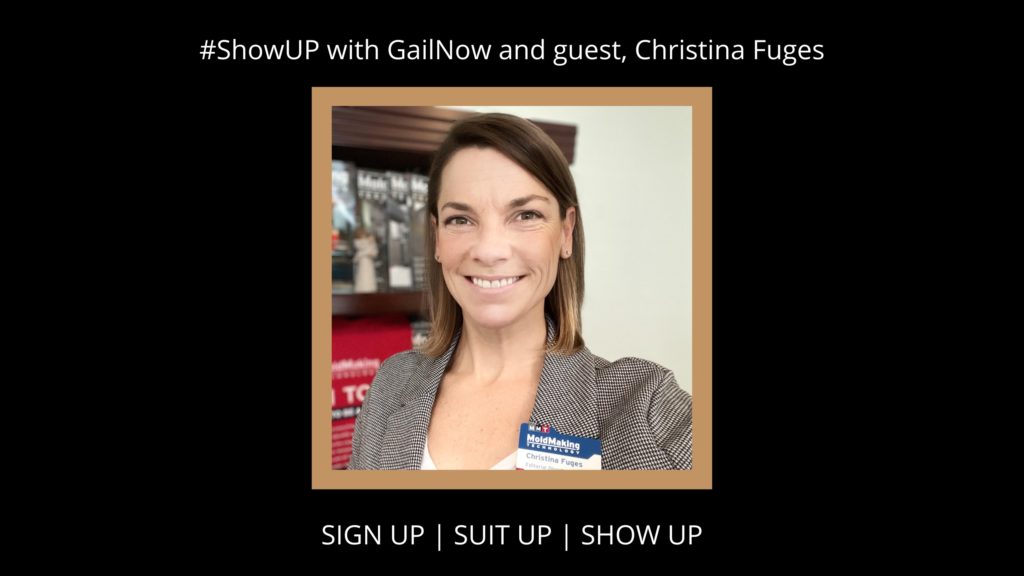I recently had the pleasure of interviewing Christina Fuges on #ShowUP with GailNow. She has 28 years of experience in trade publishing and has been the Editorial Director of Moldmaking Technology Magazine for 23 of those years. She was a founding partner of Communication Technologies, Inc. (CTI), which launched the publication and its annual trade show, the MoldMaking Expo (now Amerimold expo) where she is the Technical Conference Director.
She and I initially met on Twitter and through online tweeting back and forth, we kind of did the Twitter dance; liking and sharing things. Lo and behold, we found we had things in common and we eventually met in person at the Amerimold Expo in 2021.
She is someone who truly understands the power of building and sharing stories, especially in this new digital world. Recently, there has been a lot of disruption when it comes to how these stories are being told in various industries, but especially in manufacturing. The companies and the individuals that know how to use social media, as well as still connect with trade shows and meet in person, are the ones that are really rocking it!
She and I touched on many subjects, but mainly focused on her background and transferable skills, shifting to digital, as well as the Power of Telling your Story.
Christina received her bachelor’s degree in telecommunications from Wilkes University in Wilkes-Barre, Pennsylvania. After that she ended up at a local company that was a tradeshow management company that put on quilting shows. They also had a quilting conference, as well as a quilting newsletter at the time. She was involved in creating content, helping with conference development and setting up trade shows with quilting. Through this experience, Christina learned that anything in the trade business (an object or even a process) has a trade publication.
From there, she went on to editing; eventually starting with partners. Before she first started at MMT, she had no idea what moldmaking was, but used her curiosity to gain some knowledge on the topic. Throughout her career, she has, like most of us, has built up her transferable skills and uses them in her current role, even in changing her approach during the pandemic.
“So, it’s that was a favorable experience and it didn’t take me too much when you talk about transferable skills, like I like to think about my organizational skills, my communication skills, relationship building skills, listening creativity, when you’re writing an article, pretty much the same skills in order to get that content to share it.
Leaders have many functions and one of them is to influence others, including their subordinates, their stakeholders, and their company’s customers.
According to the Cambridge Dictionary, the word influence is defined as “the power to have an effect on people or things, or a person or thing that is able to do this”.
There are many avenues through which they are able to assert their influence, but no matter how it’s delivered, influence doesn‘t happen through conveying information or reciting facts and figures listed in a presentation.
Leaders achieve influence when they reach people in ways that enable them to understand, remember, and inspire them to take action. Influence is about changing ideas, as well as changing behavior and it enables learning to be sustainable.
One of the best ways to influence is through storytelling!
According to an article in Harvard Business Publishing, telling their story helps leaders to influence, teach and inspire others in a very powerful way.
Forbes says that most businesses are known only by their name or logo. Large organizations or highly recognised ones with big public relations and big marketing budgets, can get away with this strategy. For new brands with small marketing budgets, the most powerful public relations strategy is to tell the personal, and sometimes vulnerable, story behind their brand.
Here are a few reasons why telling your story is SO important as per an article found on Ginger Leadership Communications’ website:
- Stories draw upon the universal human need for connection; in some rudimentary sense, we need stories.
- One of the most compelling ways of inspiring others is to use the one tool you have that no one else has – your personal story. Your individual experience of the world is the most valuable asset you possess!
- Despite what we may think about business, character trumps credentials at this present moment.
- Telling your story – including all its challenges, mistakes, failures, pain, setbacks as well as its joys, successes and victories – says something about what it means to be human. Telling your story can even inspire others to take the first step on their own path to becoming a public speaker!
Storytelling is immensely effective for learning according to Harvard Business. Here’s why:
- Storytelling establishes connections among people, and also between people and ideas.
- Stories tell the culture, history, and values that unite people.
- When it comes to our countries, our communities, and our families, we understand instinctively that the stories we hold in common are an important part of the ties that bind us to each other.
- This understanding is also true in the business world, where an organization’s stories, and the stories told by its leaders, help strengthen relationships in a way that factual statements summarized in bullet points or numbers don’t.
Christina and I found that stories are now being told differently. Now, people no longer need to wait for print and stories can be shared instantly. Read this excerpt to learn about Christina’s experience with the change, especially in the last while.

“When COVID hit, everything was just accelerated and I took that as an opportunity. Not everybody’s comfortable, we can get into that, too; but, it was just so exciting back in February, March 2020. Not only did it give me an opportunity to go back to what I went to school for, for my current job and deliver content to a community right in need of it, but at a time also when they needed to share their stories because this community of mold building and molding, almost saving the day during this pandemic, in terms of the equipment and the components that were needed. It was an opportunity to shine light on and you couldn’t really wait for print, right? There’s noway you can wait for a story to come out. We turned to video, to social media; this helped us amp up the activity that we were already doing… So transferring that to video content or digital content, social, it was pretty seamless for me. I am not a technical person; something goes wrong with a computer, I am one of those people that freaks out. So, being able to do this and being comfortable with yourself and delivering content in a new way; if I can do it, I think anybody can and should do it.”
When it comes to video content, Christina feels that we all struggle with wanting to put out the best, but getting the content done and out there is more important than striving for perfection. It also helps the guest if the host is more real.

“Yeah, just real, right? Don’t overthink. That was the struggle when I started doing the MMT chat, some people wanted to make them better. First of all, I could do it by myself, so it was a timely thing; let’s just get this done. To me, the important part was the connection, getting it done quickly to get these COVID-related stories, these positive stories out quickly. So I’m doing it. And then it was like, you know, it doesn’t need to be better. First of all, that’s subjective and I like the down and dirty. I’m just being real and it comes. I think sometimes that makes the guest more comfortable when you just don’t over-produce it. Now there are other times when, depending on what the subject matter is, it calls for that, but I agree with you most on social media; it doesn’t just get it out there.”
Lastly, she shared some tips that can be applied by us all:
- Don’t be afraid to ask for help.
- Build that community and lean on that community to help them get better.
- Do your part by sharing a story or even convincing someone that they have a story to share.
If we embrace these, they can help us to show up, connect, engage, appeal to others; teaching, inspiring and motivating them as we go, especially when we share our own story.
Paulo Coelho once said it so well:
“Tell your story: yes, tell your story! Give your example. Tell everyone that it’s possible, and other people will then have the courage to face their own mountains.”

Hear full interview on YouTube: https://youtu.be/vxQwLf9uM4c
